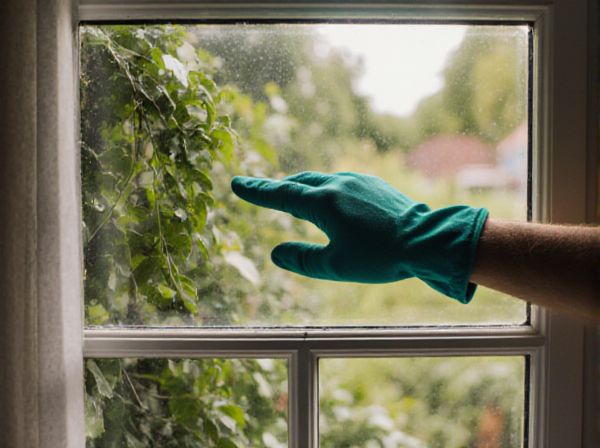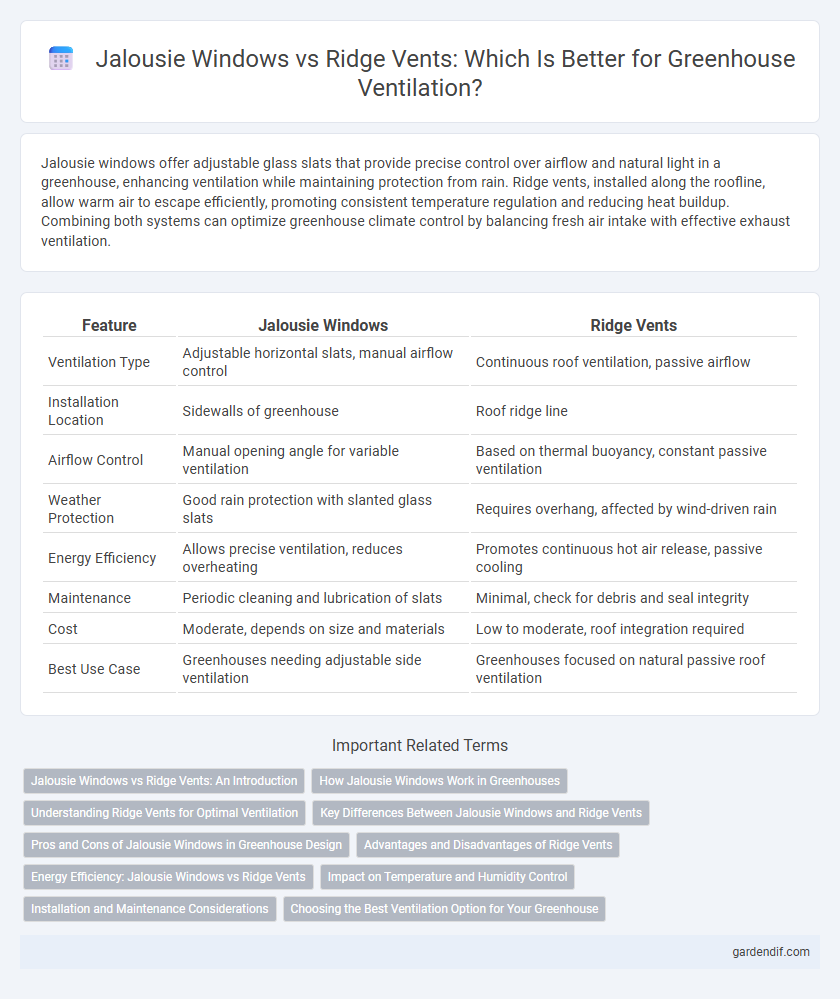
Jalousie windows vs ridge vents Illustration
Jalousie windows offer adjustable glass slats that provide precise control over airflow and natural light in a greenhouse, enhancing ventilation while maintaining protection from rain. Ridge vents, installed along the roofline, allow warm air to escape efficiently, promoting consistent temperature regulation and reducing heat buildup. Combining both systems can optimize greenhouse climate control by balancing fresh air intake with effective exhaust ventilation.
Table of Comparison
| Feature | Jalousie Windows | Ridge Vents |
|---|---|---|
| Ventilation Type | Adjustable horizontal slats, manual airflow control | Continuous roof ventilation, passive airflow |
| Installation Location | Sidewalls of greenhouse | Roof ridge line |
| Airflow Control | Manual opening angle for variable ventilation | Based on thermal buoyancy, constant passive ventilation |
| Weather Protection | Good rain protection with slanted glass slats | Requires overhang, affected by wind-driven rain |
| Energy Efficiency | Allows precise ventilation, reduces overheating | Promotes continuous hot air release, passive cooling |
| Maintenance | Periodic cleaning and lubrication of slats | Minimal, check for debris and seal integrity |
| Cost | Moderate, depends on size and materials | Low to moderate, roof integration required |
| Best Use Case | Greenhouses needing adjustable side ventilation | Greenhouses focused on natural passive roof ventilation |
Jalousie Windows vs Ridge Vents: An Introduction
Jalousie windows provide adjustable louvered glass panels that allow precise airflow control and natural ventilation, making them ideal for greenhouses needing customizable temperature regulation. Ridge vents, installed along the roof peak, enable continuous passive ventilation by allowing hot air to escape uniformly, enhancing overall airflow without mechanical systems. Choosing between jalousie windows and ridge vents depends on specific greenhouse design requirements for airflow, humidity control, and structural integration.
How Jalousie Windows Work in Greenhouses
Jalousie windows in greenhouses operate by allowing adjustable louvered glass slats to open and close, facilitating precise airflow control and natural ventilation. These windows enable effective temperature regulation by promoting cross-ventilation, which reduces humidity and prevents overheating. Their design supports energy efficiency by maximizing fresh air circulation while maintaining protection against pests and rain.
Understanding Ridge Vents for Optimal Ventilation
Ridge vents are designed to run along the peak of a greenhouse roof, allowing warm, humid air to escape naturally through convection, enhancing airflow and preventing heat buildup. Unlike jalousie windows that rely on manual adjustment for airflow control, ridge vents provide continuous, passive ventilation crucial for maintaining stable internal temperatures and humidity levels. Proper installation of ridge vents ensures optimal greenhouse ventilation, promoting plant health and energy efficiency by reducing the risk of mold and overheating.
Key Differences Between Jalousie Windows and Ridge Vents
Jalousie windows use adjustable glass or acrylic slats to allow controlled airflow and natural ventilation in a greenhouse, providing flexibility in air regulation and protection against rain. Ridge vents are fixed ventilation systems installed along the peak of a greenhouse roof, designed to facilitate continuous hot air exhaust by natural convection, enhancing temperature control and humidity management. The key differences lie in their placement, operation mechanism, and airflow control precision, with jalousie windows offering manual adjustment and ridge vents providing passive, consistent ventilation.
Pros and Cons of Jalousie Windows in Greenhouse Design
Jalousie windows in greenhouse design offer excellent ventilation control and enhanced airflow, promoting optimal temperature and humidity levels for plant growth. Their adjustable slats allow for customizable air exchange, reducing overheating risks; however, they may lack energy efficiency compared to ridge vents due to potential air leakage. Maintenance requirements can be higher, as slats and mechanisms are prone to wear and damage from greenhouse humidity.
Advantages and Disadvantages of Ridge Vents
Ridge vents provide continuous airflow along the peak of a greenhouse roof, enhancing ventilation by allowing hot air to escape uniformly and reducing heat buildup. They are low-profile and weather-resistant, minimizing the risk of water intrusion and structural damage compared to jalousie windows, which can be prone to leaks and require manual operation. However, ridge vents may be less effective in low-wind conditions and do not offer adjustable ventilation control like jalousie windows, which can be partially opened for precise airflow management.
Energy Efficiency: Jalousie Windows vs Ridge Vents
Jalousie windows provide adjustable ventilation by allowing precise control of airflow, which can reduce the need for electrical cooling and improve energy efficiency in greenhouses. Ridge vents facilitate passive ventilation by promoting natural hot air escape through the roof's peak, lowering indoor temperatures without energy consumption. Comparing energy efficiency, ridge vents typically offer continuous, low-energy cooling, while jalousie windows enable targeted ventilation but may require manual adjustment to optimize airflow.
Impact on Temperature and Humidity Control
Jalousie windows provide adjustable slats that allow for precise control over airflow, significantly improving temperature regulation within a greenhouse by enabling consistent fresh air intake. Ridge vents promote natural convection by releasing hot, humid air from the greenhouse's highest point, effectively reducing internal humidity and preventing overheating. Optimizing the combination of jalousie windows and ridge vents enhances climate control, balancing temperature and humidity to create ideal growing conditions for plants.
Installation and Maintenance Considerations
Jalousie windows require precise installation to ensure proper sealing and weatherproofing, often demanding professional expertise due to their multiple movable glass slats. Maintenance involves regular cleaning and lubrication of the pivot mechanisms to prevent rust and ensure smooth operation. Ridge vents offer simpler installation along greenhouse roof ridges with continuous airflow benefits but need periodic inspections to clear debris and prevent blockages for optimal ventilation efficiency.
Choosing the Best Ventilation Option for Your Greenhouse
Jalousie windows offer adjustable slats that provide precise control over airflow and temperature, ideal for managing humidity in greenhouses. Ridge vents, positioned along the roof peak, enable continuous hot air escape, promoting natural convection and reducing heat buildup efficiently. Selecting the best ventilation depends on the greenhouse size, climate, and crop requirements, with jalousie windows excelling in customizable ventilation and ridge vents ensuring consistent thermal regulation.
Jalousie windows vs ridge vents Infographic

 gardendif.com
gardendif.com